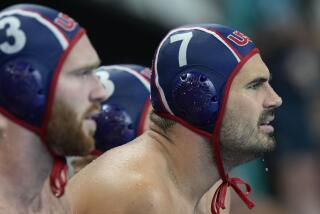Skiing : At Calgary, U.S. Ski Team Hit an All-Time Low
- Share via
The United States has become a third-rate skiing power.
That’s the only conclusion that can be drawn from the XVth Olympic Winter Games, which mercifully came to an end last Sunday. Despite the millions of dollars in corporate and individual financing that the sport has received since the 1960s, this country’s showing at Calgary represented an all-time low in terms of medals and top-10 placings: zero and one, respectively.
All six U.S. medals, two of them gold, were won by skaters.
Americans have never been winners in Nordic skiing, although Bill Koch took a silver medal in the 30-kilometer cross-country race at Innsbruck, Austria, in 1976, and Jeff Hastings managed a fourth place in the 90-meter jump at Sarajevo, Yugoslavia, in 1984.
This time, Joe Holland’s 19th in the combined and Mark Konopacke’s 18th in the 70-meter jump were the only top-20 U.S. finishes in Nordic competition.
The big crash, though, occurred in Alpine skiing, which supplied five of the eight medals won by Americans in ‘84, including three of the four golds. In 10 Alpine events on Mt. Allan, only Edith Thys, in the women’s super-G, could crack the top 10, coming in ninth.
On the basis of the ’88 Games, Switzerland, Austria, West Germany and Italy (meaning Alberto Tomba) have to be ranked in the top group. On the second level are France, Canada, Yugoslavia, Sweden and possibly Liechtenstein. Each of these countries won at least one Alpine medal.
On the bottom tier are the other nations that participate in World Cup racing each winter, including Spain, Czechoslovakia, Japan and the United States. In the Winter Olympics, you also get people from China, Argentina, Morocco, Lebanon, etc., who show up on the international Alpine scene only once every four years. The U.S. Ski Team is not in that category, yet.
The obvious answers to what went wrong in the post-Sarajevo years are that three of the five medalists--the Mahre twins and Christin Cooper--retired; the other two--Bill Johnson and Debbie Armstrong--were injured and unable to regain peak form, as were four medalists in recent World Championships--Diann Roffe, Eva Twardokens, Tamara McKinney and Doug Lewis.
And then there was Pam Fletcher’s accident on the morning that the women’s downhill was scheduled. She probably would not have won a medal but could have been in the top 10.
Just the same, ski racers retire and are hurt all the time. The Swiss and the Austrians also face those problems each winter, then somehow come up with replacements.
Said Tiger Shaw, whose 12th in the giant slalom was the top finish by a U.S male skier at Calgary: “There’s no question that the U.S. Ski Team’s development program was short-changed during the years the (Mahre) twins were winning. It wasn’t their fault. They just went about their business and trained in their own way.
“But now we seem to have a good organization that is trying to develop younger skiers, and it should pay off by 1992.”
The United States, indeed, won four medals in the World Junior Championships at Madonna di Campiglio, Italy, during the last week of January and finished first, just ahead of Austria, in unofficial Nations’ Cup-type scoring.
John McMurtry, who was appointed last summer to direct the U.S. development efforts, said that besides the medal performances by Jeremy Nobis, who won a gold in super-G and a bronze in giant slalom; Tanis Hunt, who won a silver in slalom, and Krista Schmidinger, who won a silver in Alpine combined, “Picabo Street was skiing to a top-five finish in the super-G but missed the third-to-last gate.”
The women’s team seems to have more potential in the near future, according to Roffe, who said, “We have several younger skiers ready to start getting good results, but the men have to feel more frustrated because there aren’t that many who look like they’re able to move up.”
Roffe, who won a giant slalom gold medal in the World Alpine Championships at Bormio, Italy, in 1985, won’t be 21 until later this month. Among the other promising younger women already on the team are Hilary Lindh, 18; Heidi Voelker, 18, and Kristin Krone, 19.
Felix McGrath, who finished 13th, just behind Shaw, in the giant slalom but fell in the slalom, disagreed in part with Roffe, saying: “Women just mature more rapidly than men.”
He added, however: “They also have fewer distractions and not as many other sports in which they can excel and make money.”
Concurring in this was Phil Mahre, who won a gold medal in the slalom at Sarajevo, while brother Steve took the silver. Explaining the lack of U.S. success at the ’88 Games, he said: “People are just too soft. There’s not enough heart anymore. The gifted (American) athletes are in other sports.”
McGrath, however, said: “Americans are willing to work. I’ve never worked harder than I have this winter.
“It may be difficult for us to accept, but the only way we can win is to race in Europe and spend most of our time there. The twins recognized that, and they were successful.
“We’ll never be competitive unless we face that fact, and anyone who doesn’t want to, shouldn’t be in ski racing.”
So, maybe there’s hope that with enough money properly channeled, enough young racers in the pipeline, and enough time in the Alps, U.S. skiers will be able to mount the podium again, instead of still being on the course while the victory photos are being taken.
More to Read
Go beyond the scoreboard
Get the latest on L.A.'s teams in the daily Sports Report newsletter.
You may occasionally receive promotional content from the Los Angeles Times.






